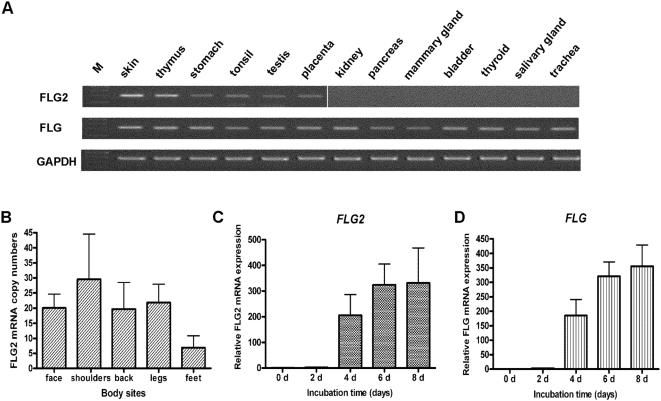Ulf Meyer-Hoffert Valerie Rahoul
Expression of Flg2 in the epidermis of wild-type and calpastatin transgenic mice. A, Representative sections of paraffin-embedded skin from wild-type (WT) and calpastatin-overexpressing (TG) transgenic mice were analyzed by indirect immunofluorescence with anti-Flg2 antibodies. Flg2 was localized to granule cells and lower corneocytes.
The dotted lines indicate the dermal-epidermal junction. Scale bars, 10 m. B, detection intensity was quantified (n 4) and found to be higher in TG mice. *, p 0.05. C, epidermal proteins from WT and transgenic mice were sequentially extracted in isotonic buffers containing either Nonidet P-40 (TE-NP40) or 8 M urea (TEU).

Equal volumes of each extract were separated on 7.5% acrylamide gels and proteins were immunoblotted with anti-Flg2 antibodies (top) and a monoclonal antibody against actin (Act; bottom ). A representative image of at least three different experiments is shown. In the upper panel, arrows indicate full-length Flg2 and a 200 kDa transformed form, and the arrowhead indicates a 55 kDa fragment. The molecular masses of the standards are indicated in kDa on the left.
Molecular identification of the FLG2 gene. (A) Schematic physical map of the human SFTP gene locus (1q21.3). Genes are ordered from centromere to telomere. TCHH, trichohyalin; RPTN, repeatin.
HRNR, hornerin; FLG, filaggrin; FLG2, filaggrin-2; CRNN, cornulin; LCE5A, late corneal envelope 5A. (B) Schematic diagram of the FLG2 gene, based on a composite cDNA isolated from foreskin-derived keratinocytes identified by overlapping RT-PCR and RACE-PCR. It is composed of three exons and two introns.
The positions of exons (boxes) and introns (curved lines) of FLG2 are deduced by comparing its full-length cDNA sequence with the corresponding genomic DNA. Untranslated regions 59 and 39 and coding sequences are indicated by open and black filled boxes respectively.
The complete nucleotide sequence has been submitted to Gen-Bank TM with accession number AY827490. doi:10.1371/journal.pone.0005227.g001
